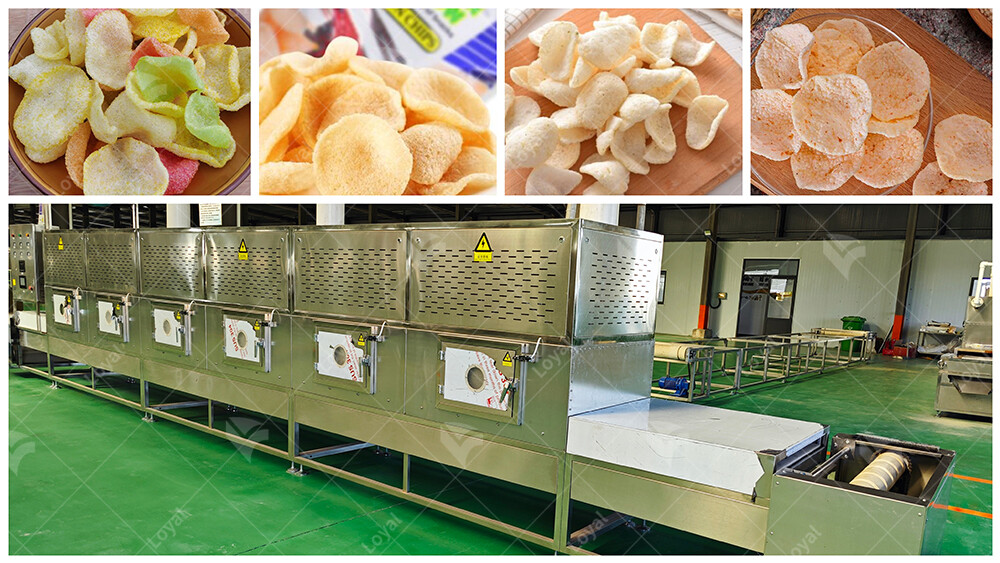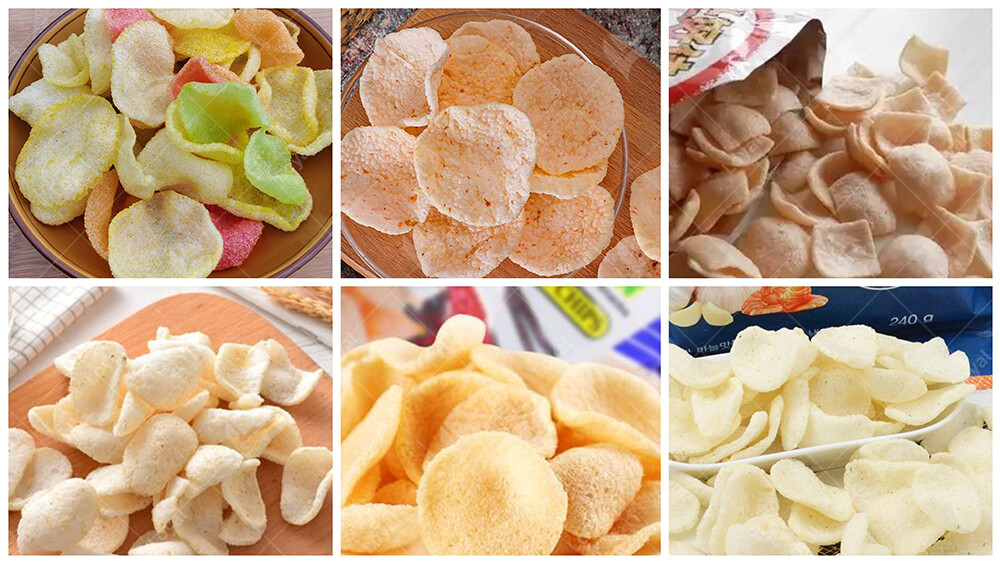The Ultimate Non - Fried Snack Food Microwave Baking Machine Guide to 2024
Introduction to Non-Fried Snack Food Microwave Baking Machines
Non-fried snack foods have gained popularity due to their healthier profile and consumer demand for alternatives to traditional fried snacks. In response to this trend, the food industry has turned to innovative solutions like Non-Fried Snack Food Microwave Baking Machines. These machines offer a healthier way to produce snacks by utilizing microwave technology instead of frying.
Non-fried snack food microwave baking machines are designed to bake snacks such as chips, crackers, and pretzels without the need for oil or fat. This makes them an attractive option for health-conscious consumers and food manufacturers looking to reduce the fat content of their products. With the increasing focus on health and wellness, these machines play a crucial role in meeting consumer demand for healthier snack options.

Understanding the Principles of Microwave Baking Technology
Microwave baking technology revolutionizes the way snack foods are prepared, offering a healthier alternative to traditional frying methods. This innovative process utilizes electromagnetic waves to heat food quickly and evenly, resulting in crisp and delicious snacks without the need for excessive oil or fat. By harnessing the power of microwaves, manufacturers can achieve the desired texture and flavor while reducing the negative health effects associated with frying.
Microwave baking operates on the principle of dielectric heating, where food absorbs electromagnetic radiation and converts it into heat energy. Unlike conventional ovens that rely on conduction and convection, microwaves penetrate the food and agitate water molecules, generating heat from within. This rapid and uniform heating process ensures that snacks are cooked thoroughly and evenly, eliminating the risk of undercooked or burnt spots.
One of the key advantages of microwave baking technology is its ability to preserve the nutritional integrity of snack foods. By eliminating the need for excessive oil, manufacturers can produce healthier alternatives to traditional fried snacks. This not only caters to health-conscious consumers but also aligns with industry trends towards clean-label products with minimal processing.

Key Components of Non-Fried Snack Food Microwave Baking Machines
Non-fried snack food microwave baking machines consist of several essential components that work together to deliver efficient and consistent results. At the heart of these machines is the microwave generator, which produces the electromagnetic waves used for heating. This generator is typically housed within a sturdy casing to protect it from environmental factors and ensure safe operation.
Another critical component is the cavity or chamber where the snack foods are placed for baking. This cavity is constructed from durable materials such as stainless steel to withstand high temperatures and facilitate easy cleaning. Additionally, it is designed to reflect and distribute microwaves evenly, ensuring uniform heating throughout the baking process.
Temperature and moisture control systems are also integral to microwave baking machines, allowing operators to adjust settings according to the specific requirements of different snack products. These systems monitor and regulate parameters such as temperature, humidity, and airflow to optimize baking conditions and achieve the desired texture and taste.
Furthermore, modern microwave baking machines often feature advanced automation and control interfaces, allowing operators to program recipes, monitor process parameters, and troubleshoot issues easily. This enhances efficiency, consistency, and reliability in snack food production, making microwave baking machines indispensable tools for manufacturers seeking to meet consumer demand for healthier and tastier snack options.

Comparison with Traditional Baking Methods in the Food Industry
Traditional baking methods have long been the cornerstone of snack food production in the food industry. However, with advancements in technology, non-fried snack food microwave baking machines have emerged as a compelling alternative. These two methods differ significantly in several aspects, including efficiency, product quality, and environmental impact.
Firstly, let's consider efficiency. Traditional baking methods often require longer processing times due to the need for preheating and gradual heating of the product. In contrast, non-fried snack food microwave baking machines utilize microwave energy to rapidly heat the product, significantly reducing processing time. This increased efficiency translates to higher production capacity and lower energy consumption, making microwave baking machines a more cost-effective option for manufacturers.
Next, let's examine product quality. Traditional baking methods rely on convection heat transfer, which can sometimes result in uneven heating and inconsistent product texture. On the other hand, microwave baking machines offer precise temperature control and uniform heating, resulting in consistently crispy and delicious snack foods. Additionally, microwave baking preserves the natural flavors and nutrients of the ingredients, leading to a superior taste experience for consumers.
Furthermore, the environmental impact of both methods differs significantly. Traditional baking methods often involve the use of large ovens fueled by gas or electricity, resulting in higher carbon emissions and energy consumption. In contrast, microwave baking machines are more energy-efficient and produce fewer greenhouse gas emissions, making them a more environmentally friendly choice for snack food production.
In summary, while traditional baking methods have been the go-to choice for snack food production in the past, non-fried snack food microwave baking machines offer numerous advantages in terms of efficiency, product quality, and environmental sustainability. As the food industry continues to evolve, manufacturers must carefully consider these factors when selecting the most suitable baking method for their operations.

Factors to Consider When Selecting Non-Fried Snack Food Microwave Baking Machines
When choosing non-fried snack food microwave baking machines for your production line, several key factors must be taken into account to ensure optimal performance and efficiency. From technological specifications to practical considerations, here are some essential factors to consider:
Firstly, evaluate the technical specifications of the microwave baking machine, including power output, frequency, and capacity. Higher power output and frequency generally result in faster processing times and higher production capacity, but it's essential to ensure that the machine's specifications align with your production requirements.
Additionally, consider the size and layout of your production facility when selecting a microwave baking machine. Ensure that the machine's dimensions fit comfortably within your available space and that it can be easily integrated into your existing production line without causing disruptions.
Another crucial factor to consider is the machine's reliability and durability. Choose a reputable manufacturer with a proven track record of producing high-quality microwave baking machines that are built to last. Investing in a reliable machine will minimize downtime and maintenance costs, ensuring smooth and uninterrupted production.
Furthermore, consider the ease of operation and maintenance of the microwave baking machine. Look for features such as intuitive controls, automatic cleaning systems, and accessible maintenance points to streamline operation and reduce labor costs.
Finally, don't forget to consider the overall cost of ownership, including initial purchase price, ongoing maintenance costs, and energy consumption. While it's essential to stay within budget, prioritize quality and performance to ensure long-term success and profitability.
By carefully considering these factors when selecting non-fried snack food microwave baking machines, you can ensure that your production line operates efficiently, reliably, and cost-effectively, delivering high-quality snack foods to satisfied consumers.

Installation and Setup Guidelines for Efficient Operation
To ensure the optimal performance of a Non-Fried Snack Food Microwave Baking Machine, proper installation and setup are crucial. Here's a comprehensive guide to help you get started:
1. Location Selection: Begin by selecting an appropriate location for the machine. Ideally, it should be placed in a clean, well-ventilated area with sufficient space for operation and maintenance access. Avoid areas prone to moisture or extreme temperatures, as these can affect the machine's performance.
2. Power Requirements: Before installation, ensure that the electrical supply meets the machine's power requirements. Consult the manufacturer's specifications for voltage, phase, and current ratings. It's essential to have a dedicated power outlet to prevent overloading and ensure consistent operation.
3. Assembly and Placement: Follow the manufacturer's instructions carefully to assemble the machine correctly. Pay attention to the alignment of components and securely fasten all parts to prevent any potential hazards during operation. Once assembled, place the machine on a stable and level surface to prevent vibrations or movement during use.
4. Calibration and Testing: After installation, it's essential to calibrate the machine to ensure accurate temperature and timing settings. Follow the manufacturer's guidelines for calibration procedures, and conduct thorough testing to verify the machine's functionality. Test-run the machine with a small batch of snack food to check for even heating and consistent results.

Maintenance and Troubleshooting Tips for Longevity
Regular maintenance is key to extending the lifespan of your Non-Fried Snack Food Microwave Baking Machine and preventing downtime. Here are some essential maintenance and troubleshooting tips:
1. Cleaning and Sanitization: Regularly clean the machine's interior and exterior surfaces to remove food residues, grease, and debris. Use mild detergents and sanitizers recommended by the manufacturer to maintain hygiene standards. Pay special attention to removable components such as trays, racks, and filters, and clean them thoroughly after each use.
2. Inspecting Components: Periodically inspect the machine's components for signs of wear, damage, or malfunction. Check for loose or damaged parts, frayed wires, and worn-out seals or gaskets. Replace any faulty components promptly to prevent operational issues or safety hazards.
3. Lubrication and Adjustment: Lubricate moving parts such as hinges, bearings, and conveyor belts according to the manufacturer's recommendations. Ensure proper tension and alignment of belts and chains to prevent slippage or misalignment. Periodically check and adjust the machine's settings for temperature, power, and timing to maintain optimal performance.
4. Troubleshooting Common Issues: Familiarize yourself with common issues that may arise during operation, such as uneven heating, power fluctuations, or sensor malfunctions. Refer to the machine's user manual for troubleshooting guidelines and follow step-by-step procedures to identify and resolve problems effectively. If the issue persists, contact the manufacturer or a qualified technician for assistance.
By following these installation, setup, maintenance, and troubleshooting guidelines, you can ensure the efficient operation and longevity of your Non-Fried Snack Food Microwave Baking Machine, maximizing productivity and product quality.

Safety Protocols and Regulations for Operating Microwave Baking Machines
Microwave baking machines are sophisticated pieces of equipment designed to efficiently bake snack foods without the need for frying. To ensure safe operation and compliance with regulations, it's essential to follow specific safety protocols and adhere to industry standards.
Firstly, it's crucial to conduct thorough training for all personnel involved in operating microwave baking machines. This training should cover proper equipment usage, emergency procedures, and safety precautions. Employees should understand the risks associated with microwave technology, including the potential for electrical hazards and burns.
Secondly, regular maintenance and inspections are paramount to ensure the safe operation of microwave baking machines. Routine checks should include examining electrical components, verifying the integrity of seals and gaskets, and cleaning the interior of the machine to prevent the buildup of debris that could pose a fire risk.
Additionally, operators should strictly adhere to manufacturer guidelines regarding load capacity and operating parameters. Overloading the machine or deviating from recommended settings can lead to equipment malfunction and safety hazards. It's essential to monitor baking temperatures and cooking times closely to prevent overheating and ensure consistent product quality.
Lastly, compliance with regulatory standards is non-negotiable when operating microwave baking machines. Depending on the jurisdiction and the nature of the operation, this may include adherence to standards set by organizations such as the Occupational Safety and Health Administration (OSHA) or the Food and Drug Administration (FDA). Failure to comply with these regulations can result in fines, legal consequences, and, most importantly, compromised safety for personnel.
In conclusion, safety protocols and regulations for operating microwave baking machines are vital to protect both personnel and the integrity of the product. By implementing thorough training, conducting regular maintenance, adhering to manufacturer guidelines, and ensuring regulatory compliance, operators can mitigate risks and create a safe working environment.

Future Trends and Innovations in Non-Fried Snack Food Microwave Baking Technology
As the demand for healthier snack options continues to rise, the non-fried snack food industry is experiencing a surge in innovation, particularly in microwave baking technology. Looking ahead to the future, several trends and advancements are shaping the landscape of non-fried snack food production.
One significant trend is the development of advanced microwave baking machines equipped with cutting-edge features to enhance efficiency and product quality. These machines may incorporate intelligent controls, precision heating systems, and automated processes to streamline production and ensure consistency.
Another emerging trend is the use of novel ingredients and formulations to create healthier and more flavorful snack options. Manufacturers are experimenting with alternative flours, natural sweeteners, and functional ingredients to meet consumer demand for products that are low in fat, sugar, and artificial additives while still delivering on taste.
Additionally, there is growing interest in sustainable packaging solutions for non-fried snack foods, driven by consumer concerns about environmental impact. Manufacturers are exploring biodegradable materials, recyclable packaging, and innovative designs to reduce waste and minimize the carbon footprint of their products.
Furthermore, advancements in food safety technology are playing a crucial role in the future of non-fried snack food microwave baking. From improved sanitation systems to enhanced quality control measures, these innovations are helping manufacturers maintain high standards of safety and hygiene throughout the production process.
Overall, the future of non-fried snack food microwave baking technology is bright, with continued focus on innovation, sustainability, and food safety. By staying abreast of these trends and embracing new technologies, manufacturers can meet consumer demands for healthier, tastier snack options while driving industry growth and innovation.

References
1. IEEE Xplore Digital Library
Website: [https://ieeexplore.ieee.org/]
2.ScienceDirect
Website: [https://www.sciencedirect.com/]
3. SpringerLink
Website: [https://link.springer.com/]
4. Wiley Online Library
Website: [https://onlinelibrary.wiley.com/]
5. PubMed
Website: [https://pubmed.ncbi.nlm.nih.gov/]
 Telephone :+86-531-55583139
Telephone :+86-531-55583139 WhatsApp :+86 13256674591
WhatsApp :+86 13256674591 Email :
Email :










